useful interview expressions game
useful interview expressions: Practice useful interview expressions game using this ESL fun Game.This game is also excellent for classroom teaching. Teachers can engage students in a classroom vocabulary or grammar review. It is suitable for intermediate and advanced esl learners. It can be used to energize a dull class, to review work that was done or simply as a reward for good classroom work. Have fun teaching and learning English!
Three lessons from the science of how to teach writing
What’s the best way to teach writing? The experts have many answers — and they often contradict each other. In contrast to the thousands of studies on effective methods for teaching reading and mathematics, there are relatively few rigorous studies on writing instruction. That’s partly because it’s time-consuming and expensive to assess writing quality in a way that can be quantitatively measured. Commonly, researchers come up with an eight-point scale. They write descriptions and sample essays to show what each score involves.
Conversation Questions for the ESL/EFL Classroom
If this is your first time here, then read the Teacher's Guide to Using These PagesIf you can think of a good question for any list, please send it to us. Home | Articles | Lessons | Techniques | Questions | Games | Jokes | Things for Teachers | Links | Activities for ESL Students Would you like to help? If you can think of a good question for any list, please send it to us. If you would like to suggest another topic, please send it and a set of questions to begin the topic.
Parker -Delivering a Persuasive Speech
The Internet TESL Journal Douglas Parkerbps2 [at] capital.net Level:Upper-intermediate to advancedOverview:Students need to understand that how they say something and how they physically present themselves are just as important as what they say. By understanding the dynamics involved in effective persuasive speaking, students will improve their overall confidence in communicating.Purpose:The purpose of this lesson is to improve studentsâ speaking skills by understanding persuasion proficiencies.
The Teacher’s Guide to Using YouTube in the Classroom
YouTube is one of the most popular websites on the planet and a vast resource for educational content. The site is home to over 10 million videos tagged as educational, many of them submitted by your fellow teachers. A completely free resource this huge and varied has nearly endless potential for the classroom. Here are some ideas and suggestions to get you started.
Strengthening Lessons with a Student Work Protocol
As the chill in the air gets chillier, and your stacks of student work pile up like fallen leaves, why not pause, take a breath, and take a moment to look at that student work in a new way. Sure, you need to look at the work to assess student progress, provide feedback, and celebrate student successes, but you can also use it to assess, refine, and celebrate your own work. The EQuiP Student Work Protocol is one way to do just that. In part one of our series with Achieve.org, we introduced you to their work with EQuIP (Educators Evaluating the Quality of Instructional Products), an initiative designed to identify high-quality materials aligned to the Common Core.
Google for Educators: The Best Features for Busy Teachers
Google Search Google Search is at the heart of it all. It’s where many of us go multiple times a day to locate information. Google provides excellent resources for teachers and students to become effective searchers and build essential digital literacy skills for finding quality, credible resources on the web. Here you can find lesson plans, an online course to become a Power Searcher, and challenges such as A Google a Day. In my opinion, it all starts here for our students -- helping them to become digitally aware of the information that they're intaking is of utmost importance.
The unexpected math behind Van Gogh's "Starry Night" - Natalya St. Clair
A few lesson plans exist for teaching visual arts and self-similarity (objects that have the same pattern) that could be used after showing this lesson. Shodor has some free lesson plans for students in grades 4 through 8. High school students can learn recursion algorithms to create the Koch curve using Scratch for free. Educational technologist Dylan Ryder has also written about creating fractals. A beautiful app worth checking out is Starry Night Interactive App by media artist Petros Vrellis.



